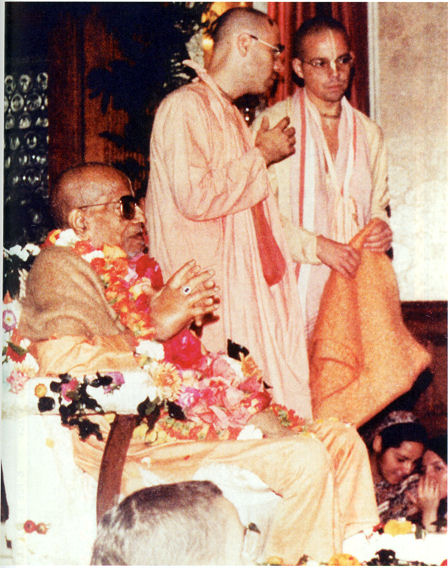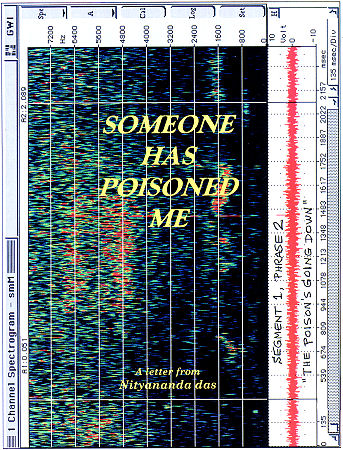

Download complete book as HTML ZIP-File
Download the E-Book: Someone has poisoned me
Someone Has Poisoned Me - BY: NITYANANDA DAS


Download complete book as HTML ZIP-File
Download the E-Book: Someone has poisoned me
The Facts About Srila Prabhupada's Poisoning by Arsenic
"So as Krishna was attempted to be killed... And Lord Jesus Christ was killed.
So they may kill me also." (Srila Prabhupada, May 3, l976, Honolulu)
"my only request is , that at the last stage don't torture me, and put me to death"
(from SPC Vol. 36, November 3, 1977 tape recorded Room Conversation)
[PLEASE NOTE: ADDRESSES, EMAILS, PHONE NUMBERS ETC. MIGHT NO LONGER BE CORRECT!]
National Audio Video Forensic Laboratory
Norman I. Perle, B.C.F.E., F.A.C.F.E.
8357 Shirley Avenue - Northridge, Ca., 91324-4146
Voice - 818/989-0990 - Fax - 818-993-8550
E-mail: perle@ix.netcom.com or 71601.771@compuserve.com
Homepage: http://ourworld.compuserve.com/homepages/perle
Board Certified Forensic Examiner: American Board Of Recorded Evidence, - Fellow, American College Of Forensic Examiners.
***Computerized Noise Removal/ Sound Enhancement: Video/Audio
Authentication: Video Enhancements; Voice ID and Comparison. State Of The Art, Full Service Recorded Evidence Forensic Laboratory.
September 22, 1997: Attention Harvey Mechanic Esq.
TAPE ANALYSIS REPORT
On August 26, 1977 I received a standard analog tape recording from your office for examination. On the label of the cassette I affixed a tamperproof Security Seal Number 16959 for identification.
My assignment was to review and analyze the recording in order to determine if the content appears to be authentic, in that the words spoken are in context and appear to be all the words spoken at the moment of time the recorded event occurred. Additionally, there should be no signs of inappropriate stopping and re-starting of the recorder as well as the other classifications of signs suggestive of falsification.
The analysis procedure included computer waveform analysis, spectrographic chart analysis, FFT spectrum frequency analysis and a critical aural review of the audio.
EXPLANATION OF ATTACHED SUPPORTIVE EXHIBITS:
The attached exhibits are the results of Waveform and Spectrogram Analysis. The upper window is a Waveform of the acquired audio. This pattern represents audio relative to time and amplitude (volume). The large lower window is a Spectrogram.
The Spectrogram represents audio relative to: 1) Time--as shown on the bottom scale, horizontal axis. 2) Amplitude--as shown as the varying shades of pattern, vertical axis. 3) Frequency-as shown in the horizontal axis.
Each exhibit is annotated with an explanation as to the area of audio acquisition, and that is located in the "Title Bar" on top of the Waveform. A more detailed explanation of the spectrogram patterns is located in the "Title Bar" above each window.
EXPLANATION OF EXHIBITS AND CONCLUSIONS:
EXHIBIT no.1 It is a display of how the sound starts on this recording.
Absent is the Recorder Start Signature. Examples of what a Start Signature looks like can be seen on EXHIBIT no. 3, no. 4, and no. 5. This is consistent with a recording made from an EDITED master recording.
EXHIBIT no. 2 Is a display of the audio located approximately 10 seconds into the recording. The deficiencies revealed are audible, and are consistent with EDITING procedures wherein WORDS are ELIMINATED or REARRANGED to CHANGE the context of what is said.
EXHIBIT no. 3 is a display of the audio located approximately eleven minutes, thirty four seconds into the recording. The deficiencies are audible and are significantly similar to what one would expect to hear and see should the Master recording be an edited version.
EXHIBIT no. 4 is a display of the audio located approximately eleven minutes thirty seven seconds into the recording. This segment is located just after the area shown in exhibit number three. This deficiency is audible and is significantly similar to what one would expect to hear and see should the Master recording be an EDITED version.
EXHIBIT no. 5 is a display of the audio located approximately twenty two minutes, thirty three seconds into the recording. This is the end of the segment(s). One can hear, as well as see on the chart, representation strikingly similar to STOP/RE-STARTS(s) signatures. There is a remnant of audio after these patterns.
EXHIBIT no. 6 is a display of the audio located at the end of sound on this recording. Similar to the beginning (Exhibit #1) there is an absence of the anticipated stop signature.
SUMMARY
In conclusion, this recording exhibits strong signs suggestive of FALSIFICATION. I do not believe that these deficiencies might possibly the product of some mechanical process or problem within the recording or duplication process, and I believe that they exist at what is considered to be a higher degree than that of a coincidence.
I strongly recommend that an independent Forensic Analysis be conducted on the Master recording in order to determine the authenticity and originality of the evidence. This analysis requires what is represented as the original recording and the original tape recorder upon which this recording was represented to be made. The forensic instrumental tests include computer analysis, FFT spectral analysis, spectrogram chart analysis, and microscopic photography of the magnetic field on the original recording. Additionally, the recordings will be compared for dissimilarities as a critical listening procedure is performed.
These tests are directed to discover (1) if the recording has been edited in any manner so as to effect the context of the words, (i.e. erasures, inappropriate starting and re-stating of the recorder), (2) If in fact the audio material is an original source recording and not a re-recorded version. The testing would determine the cause of any deficiency within the audio track and is focused on establishing an opinion as to the integrity and authenticity of the evidence.
If you have any questions, please call me.
Norman I. Perle
Srila Prabhupada left this mortal world on November 14, 1977.
But He lives forever in His instructions, and His followers will always live with Him.
"He reasons ill who tells that Vaishnavas die
While thou art living still in sound!
The Vaishnavas die to live, and living try
To spread the Holy Name around"
(Śrīla Bhaktivinoda Thākura)
HARE KṚṢṆA HARE KṚṢṆA KṚṢṆA KṚṢṆA HARE HARE
HARE RĀMA HARE RĀMA RĀMA RĀMA HARE HARE